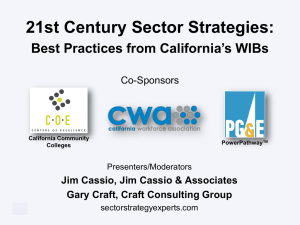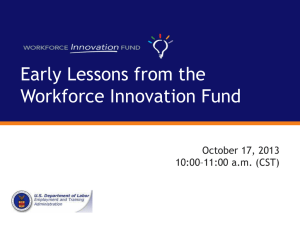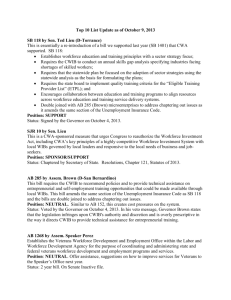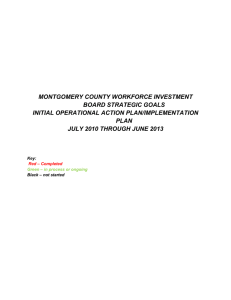Networking on the Edge of Chaos
advertisement
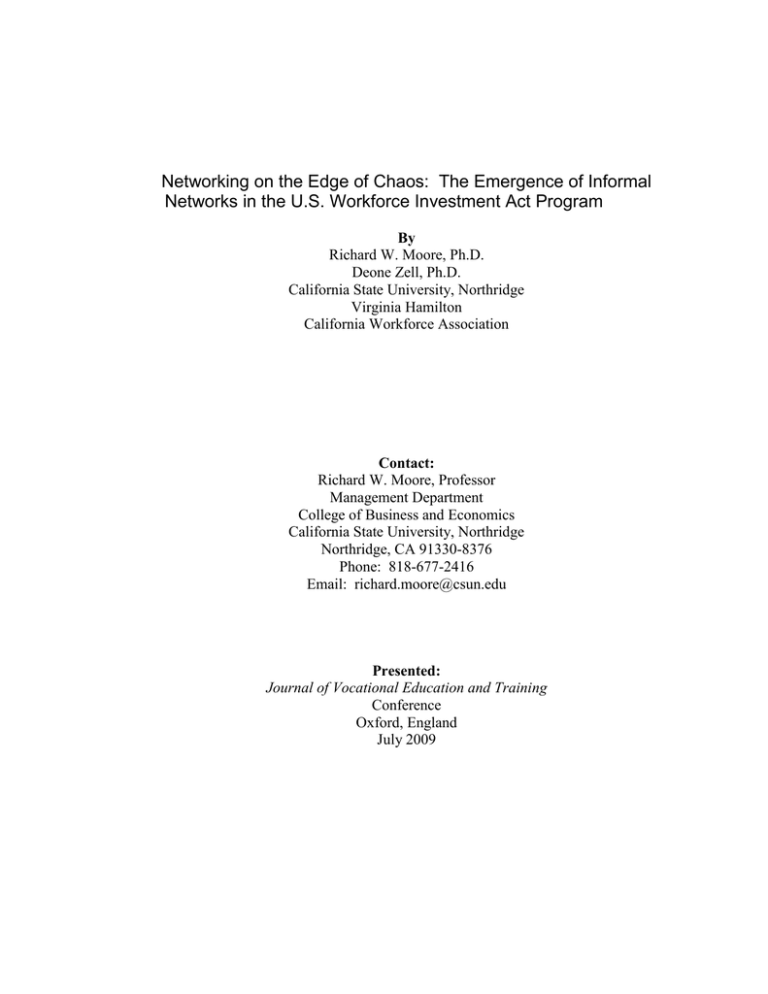
Networking on the Edge of Chaos: The Emergence of Informal Networks in the U.S. Workforce Investment Act Program By Richard W. Moore, Ph.D. Deone Zell, Ph.D. California State University, Northridge Virginia Hamilton California Workforce Association Contact: Richard W. Moore, Professor Management Department College of Business and Economics California State University, Northridge Northridge, CA 91330-8376 Phone: 818-677-2416 Email: richard.moore@csun.edu Presented: Journal of Vocational Education and Training Conference Oxford, England July 2009 Abstract Research on chaos theory in organizations finds that organizations are most responsive to their environments when they are on the edge of chaotic system (Handy, 1994). In this difficult context adaptive strategies spontaneously emerge from organizations. One such adaptive strategy is the creation of informal networks to solve common problems within the chaotic environment (Kaufman, 1995). The Workforce Investment Act is the United States’ largest nationally funded training and employment program. The program is administered through both state and local government. In California 48 local areas actually deliver program services. This paper reports on a network analysis that included all 48 local programs. The study used the latest social network analysis methods to investigate how these nationally funded but locally administered workforce development programs in California informally networked with other workforce development agencies in their local areas and with each other to form powerful regional networks to exchange information, seek additional funds and attempt to influence policy. The paper will explore implications of these informal networks for workforce development policy in the United States and elsewhere. It will also consider the applicability of chaos theory, complexity theory and social network analysis to evaluation of workforce development programs. 1 Introduction In order to mobilize the necessary human capital and other resources, the boundaries of the traditional bureau or agency must be crossed, within governments, intergovernmentally, and with Non-Governmental Organizations. One important means of boundary crossing is through collaborative networks….. (Agranofff, 2007, p.221) More and more policymakers recognize that important social problems can only be solved by bringing together a wide range of people and organizations, public and private, for-profit and non-profit, into networks. Policymakers, researchers and practitioner agree that the only way workforce development systems can meet the challenges of a complex and rapidly shifting labor market is through “collaboration”. Knowledge about how collaboration develops and what impact it actually has, however, remained elusive. The Workforce Investment Act (WIA) mandated collaboration by specifying the membership of state and local Workforce Investment Boards (WIBs), and creating mandatory partners in One-Stop Centers1. Despite some nascent attempts to measure collaboration within the system, little is known about the degree to which collaboration has emerged as a successful strategy for solving workforce problems over the last decade. For example Javar and Wandner (2004) looked at what agencies provide particular services in a sample of One-Stops but did not do a comprehensive network analysis. In this study we analyzed the entire population of 48 local Workforce Investment Act programs in the state of California. We examined: (1) (2) (3) how these programs networked with each other; how they worked with other local employment, training and education programs and; how they worked with state level employment, training and education agenies. Once we had measured these networks we examined how local programs’ position within the network affected their ability to win additional funding. Our Theoretical Framework 1 One-Stop Centers are comprehensive employment and training centers created by the Federal Workforce Investment Act. The centers are managed locally and funded by the states with Federal resources. The vision for the centers is that they would bring together under one roof a host of federal, state and local employment, training and education programs. In some local areas the centers are operated by local government in others their operation is contracted out to non-profit or for-profit organizations. 2 In seeking a theoretical framework to analyze networks in the workforce system we turned to three new theoretical perspectives from the field of organizational behavior. They are social network analysis, social capital theory and chaos/complexity theory. Using these theoretical frameworks a lens to examine our findings generated a host of insights for the workforce system. Social network analysis is the mapping and measuring of relationships between people. Social network analysis has grown in popularity as scholars and practitioners have realized that the value of a network lies in the relationships between individuals, rather than in the individuals themselves. Networks give rise to “social capital,” which is the “goodwill available to individuals or groups” resulting from the structure and content of social relations (Adler & Kwon, 2002:23). Social capital results when trust, connectivity, and a sense of purpose combine to create a willingness to act. This group or societal-level motivation can be applied toward various productive ends, whether to elect a president, reduce poverty, or develop the workforce. In recent years social network analysis has also become more feasible as a result of technological advances which have facilitated the capture and analysis of network data. Specifically we use a specialized software program called UCINet to empirically measure networks and social capital along the following dimensions (Scott, 2000): Tie strength measures behaviors such as type, frequency, and duration of action between two actors. Trust is made up of perceived ability, kindness and integrity. It is the basis of cooperation, and tends to be positively correlated with tie strength (McGrath & Zell, 2009). Accessibility is the degree to which an individual can be reached when needed. When accessibility is low, the value of tie strength and trust is reduced. Centrality is the number of connections linking to any given node. Generally, centrality measures activity. In-degree centrality is often a sign of popularity or prestige, while out-degree centrality is often a sign of power or influence. Density is the number of existing connections divided by the total possible connections. Sparse networks are good for acquiring new information, while dense networks are good for “getting the job done” in tough times. A second stream of research focuses on networking organizations. In recent years a number of studies have examined how government agencies work with each other and with non-profit and for-profit partners to create “Public Management Networks” or PMNs. This focus on networks has driven a shift in government’s role from providing direct services to “steering the system” by contracting for services. This shift has also been driven by the complexity of modern social problems which seldom respect the boundaries of carefully structured bureaucracies (Agranoff, 2007). 3 Chaos and complexity theory come from the natural sciences but have been adapted to organizational science. Research on chaos/complexity theory in organizations finds that organizations are most responsive to their environments when they are on the edge of chaotic system (Handy, 1994). In this difficult context adaptive strategies spontaneously emerge from organizations through self-organization (for instance, see Glassman et al., 2005). One such adaptive strategy is the creation of informal networks to solve common problems within the chaotic environment (Kaufman, 1995). In our view the networks we uncovered represent an emergent strategy local WIBs use to deal with the chaotic labor market conditions and other social problems they confront. What we don’t know is how this happens or what impact the networks have. Research Questions This study focused on three over arching research questions: 1. Do informal networks of WIBS emerge within this workforce system and what factors shape the networks? 2. Are a WIBs network characteristics related to its effectiveness? 3. What are the policy implications of WIB networks for the larger workforce system? Methods In October 2008, we surveyed all 48 local WIBs in California using an on-line questionnaire designed to assess behaviors and relationships between and within three populations: the WIBS (see Table 1), the local partners and the state agencies (see Table 2). WIBs were guaranteed anonymity, and we obtained an impressive 100% response rate.2 100% responses were obtained for the “who do you work with” question; however, we were not able to obtain complete behavioral and trust data for all WIBS. 2 4 Table 1: List of WIBS 1. Alameda County 2. Anaheim City 3. Contra Costa County 4. Foothill Employment and Training Consortium 5. Fresno County 6. Golden Sierra Consortium 7. Humboldt County 8. WIB of Imperial County 9. Kern/Inyo/Mono Employers' Training Resource 10. Kings County 11. Pacific Gateway WIB 12. City of Los Angeles WIB 13. Los Angeles County 14. Madera County 15. Workforce Investment Board of Marin 16. County of Mendocino 17. Merced County 18. Monterey County Office 19. Mother Lode Consortium 20. Workforce Investment Board of Napa County 21. NoRTEC Governing Board 22. North Central Counties Consortium 23. NOVA Consortium (North Santa Clara) 24. City of Oakland 25. Orange County 26. Richmond City 27. Riverside County 28. Sacramento Employment and Training Agency 29. San Benito County 30. San Bernardino City 31. San Diego Workforce Partnership, Inc. 32. PIC of San Francisco, Inc. 33. San Joaquin County 34. Work2Future WIN 35. PIC of San Luis Obispo County 36. County of San Mateo WIB 37. Santa Ana Workforce Investment Board 38. Santa Barbara County 39. Santa Cruz County 40. SELACO Southeast Los Angeles County 41. Workforce Investment Board of Solano County 42. Sonoma County WIB 43. South Bay Workforce Investment Board 44. Stanislaus County 45. Tulare County Workforce Investment Board 46. County of Ventura 47. Verdugo Private Industry Council 48. Yolo County Workforce WIB 5 Table 2: List of Local Partners and State Agencies Local Partners 1. Local lead economic development organization 2. Local chamber(s) of commerce 3. Community colleges 4. 4.Local educational agency K-12 5. Four year colleges and universities 6. Regional organizations (COGs, regional non-profits) 7. Local LMID (Labor Market Information Division) Unit 8. Local TANF (Temporary Assistance for Needy Families) Program 9. Community Service Block Grant Agency 10. Other regional or local business organizations State Agencies/organizations 1. EDD's Workforce Investment Division (WID) 2. California Workforce Investment Board (CWIB) 3. California Workforce Association (CWA) 4. Employment Training Panel (ETP) 5. California Department of Education 6. Chancellor’s Office of the California Community Colleges 7. California Department of Social Services Measures Each of the three measures (strength of ties, trust, accessibility) was operationalized by developing a number of questions designed to represent them. For strength of ties, questions were chosen to represent specific behaviors that WIBs might engage in with each other, and with local partners and state agencies (e.g., planning together, sharing board membership, seeking funding together). The questions varied slightly depending on the type of organization each WIB was being asked to think about, but were identical for the most part. One initial question simply asked each WIB director which organizations his/her WIB worked with. This question was used to determine the list of organizations about which each WIB was queried further. Trust was measured by asking questions about the perceived capability, benevolence and integrity of the respective WIB, local partner or state agency. One question was designed to measure accessibility. Composites were created for each of the three measures by recoding the response to each question into a high - low, two level measure. The questions, dichotomizing procedures and composite ranges for tie strength, trust and accessibility are shown in Tables 3, 4 and 5. 6 Table 3: Strength of Tie Questions and Composite Ranges Note: In addition to the questions below, all WIBs were asked, “Who have you worked with on issues, programs, or projects in the last year?” Local Partners (All Y,N) WIBs (All Y,N) State Agencies 1. Has the WIB's 1. Has your Executive 1. Do you serve on a special Executive Director sit on Director sit on this advisory group or committee? this organization's board? organization's board? (Y,N) 2. Plan together to 2. Plan together to 2. How often do you attend meet workforce needs? meet workforce needs? meetings? (Regularly, Occasionally, 3. Have a formal 3. Co-locate with this Rarely) alliance to serve clients? organization at at least 3. I often use information from 4. Co-locate with this one facility? this organization to help manage organization at at least one 4. Share a contract(s) my program (SA, A, D, SD) facility? with this organization? 5. Share a contract(s) 5. Seek funding with this organization? together with this 6. Seek funding organization? together with this 6. Have someone organization? from this organization 7. Have someone from sit on your WIB? this organization sit on the 7. Have a member of WIB? your WIB sit on this 8. Have a member of organization's board? your WIB sit on this organization's board? COMPOSITES Dichotomization: Dichotomization: Dichotomization: Y,N Y,N Regularly, Range 0-8 Range 0-7 Occasionally Rarely SA, A, D, SD Range 0-3 7 Table 4: Trust Questions and Composite Ranges Local Partners (All SA, A, D, SD) 1. This organization is highly capable of solving my community's workforce issues. 2. This organization is very concerned about the wellbeing and success of my WIB. 3. This organization shares my WIB's core values. Range 0-3 WIBS (All SA, A, D, SD) 1. This organization is highly capable of solving my community's workforce issues. 2. This organization is very concerned about the wellbeing and success of my WIB. 3. This organization shares my WIB's core values. State Agencies (All SA, A, D, SD) 1. This organization is highly capable of solving my community's workforce issues. 2. This organization is very concerned about the wellbeing and success of my WIB. 3. This organization shares my WIB's core values COMPOSITES Range 0-3 Note: Dichotomization indicated in bold: SA, A, D, SD Range 0-3 Table 5: Accessibility Question and Composite Ranges Local Partners (All SA, A, WIBs (All SA, A, D, SD) 1. If my WIB needs information, I can count on this organization to respond within 48 hours. 1. If my WIB needs information, I can count on this organization to respond within 48 hours. D, SD) State Agencies (All SA, A, D, SD) 1. If my organization needs information, I can count on this rganization to respond within 48 hours. Finally, we created some measures of effectiveness for local WIBs. We began collecting the standard labor market outcomes that the federal government uses to measure program performance. These included the percent of participants who entered employment after the leaving the program, the percent who were retained in employment for six months and earnings of participants over a six month period after leaving the program. Local WIBs may also compete for additional funding from the state. We collected data on how much money the local areas won in the 2007-08 program year in these competitions and used it as a measure of organizational effectiveness. Finally, in our analysis individual WIBs are not identified to protect their anonymity. 8 Results Our results and conclustions are organized around the three research questions posed earlier. Do informal networks of WIBS emerge within this workforce system and what factors shape the networks? California is a large state, with over 35 million people. If it were a country it would be the eighth largest economy in the world. Analysts typically break the state into a number of regional labor markets. California Regional Labor Markets Figure 1 presents data about how the WIBs described their relationship with other WIBs. Specifically it shows the responses to the overall question, “Who have you worked with on regional issues, programs or projects in the last year?” Grey (thin) lines represent one-way ties, while red lines (thicker lines) represent reciprocal ties. Beginning this analysis we had no firm idea of what networks if any may exist within the system. 9 Experienced managers suggested that there were some alliances of WIBs but no one anticipated the patterns that we uncovered. As can be seen, distinct clusters are apparent. As we examined the clusters we found they clearly reflected the geography of California. Each cluster represented a clear region which are labeled on the diagram. The graphic also shows that certain clusters appear to have more reciprocal ties than others. However, the story does not become clear until one looks only at reciprocal ties in Figure 2. Figure 1: W orking Relationships Between WIBs (one and two-way) Who do you work with on regional issues, programs or projects? No Cal Bay Area Central Coast North Bay Central Valley Border So Cal Note: Thin line is one-way; Thicker line is reciprocal 10 Figure 2 presents the ties between WIBs only, but this time only the reciprocal ties are shown - the cases where both WIBs reported they worked with each other. As noted earlier, reciprocal relationships represent true exchange – in this case, in terms of who works with whom. This figure suggests that strong and powerful relationships exist among the WIBS. Also, it becomes even more evident that the clusters vary in density and are clearly geographically driven. For example, the North Bay (north of the San Fransisco Bay) and Central Valley clusters are the densest (100% and 91% density, respectively) while the Southern California cluster is the least dense (16% density). (Four WIBs who were not reciprocally tied to any other WIBs are shown in the top left corner of the figure.) The high density of the Central Valley and North Bay clusters suggests that these groups are tightly-knit, know each other well, and work together in a variety of capacities. This density suggests that these groups may be especially effective at utilizing resources and accomplishing organizational goals collaboratively, especially in times of duress or uncertainty. Again this was not a pattern that is widely recognized by people with long experience in the field, particularly state level policy makers. The mental model of policy makers at the state level is that they managing a system of 48 autonomous local areas, but in fact they are dealing with a large network with six distinct local networks and some isolated individual local areas. Also noteworthy is that certain WIBS are performing key “boundary-spanning” roles by linking the WIB networks together, creating a “backbone” that extends through the Central Valley, Central Coast, Bay Area, and Southern California clusters. Like sparse networks, such cross-boundary linkages are healthy and make it possible to tap far-reaching resources. By analyzing the graphic below we identified seven WIBs that were boundary spanners. These WIBs represented critical linkages in the system through which other WIBs had to communicate in order for information to flow throughout the network.3 3 Another way to identify boundary-spanners is through the betweeness metric, which is discussed below. The seven boundary-spanners we identified visually were also those with the highest betweeness scores. 11 Figure 2: Working Relationships Between WIBS (Reciprocal Ties Only) Who do you work with on regional issues, programs or projects? (reciprocal ties only) Border So Cal Bay Area North Bay Central Coast No Cal Central Valley We examined the strength of ties within these regional networks, and while space precludes reporting that data we can say that we found the highest frequency of strong ties in the Central Valley cluster, North Bay cluster, and Bay Area cluster, while relatively fewer (but still strong) ties exist within the Central Coast, Northern California, and Southern California clusters. The Central Valley WIBs have recently been funded through the Partnership for the San Joaquin Valley to work together on a set of regional initiatives. In the past 10 years, both the North Bay Employment Connection and East Bay Works have sought and received funds to collaborate on regionally-based projects. High trust levels were also found to be associated with the Central Valley, North Bay and Bay Area clusters, meaning individuals in these groups rate each other highly on competence, benevolence and integrity. These high levels of trust most likely predispose the clusters to high levels of cooperation and coordination. Relationships Between WIBs and Local Partners Figure 3 shows the working relationships between WIBs and local partners, and presents the in-degree centrality of the partners. The relationships are one-way, from WIBs to local partners only. The relative centrality of the local partners (number of connections into) can be compared by looking at the ring of black around the blue nodes, 12 which is created by the black arrow-heads. Thus, the thicker the ring around the local partner, the more central, or connected, it is. (See Table 6 for numbers to back up the rings.) Figure 3: One-Way Working Relationships Between WIBS (Red) and Local Partners (Blue) Figure 6 provides centrality numbers to back-up the graphics presented on Figure 5. Most attention should be paid to the first column, which is highlighted in yellow. This column presents the percentage of WIBs who say they work with each organization. This number, which can be thought of as “work centrality”, is calculated by taking the actual number of connections leading into each local partner and dividing it by the total number of connections that could possibly lead to each local partner (from the WIBs). 13 Table 6: Working Relationships, Tie Strength, Trust, and Accessibility Metrics from WIBS to Local Partners Here we can see that WIBS have developed strong networks with local partners, with some variation that might be expected. As can be seen, Community Colleges have a centrality of 100%, which means that each and every WIB says they work with community colleges. Economic development organizations, Local K-12 agencies, and Local TANFs are all highly central to WIBS. Less central to the WIBs are four-year colleges and universities and community service block agencies – although these still have relatively high centralities, at 74% and 70%, respectively. Figures representing the tie strength, trust, and accessibility centralities are also shown. As can be seen, greatest tie strength exists between WIBs and community colleges and Local TANF agencies. Greatest trust is extended to community colleges and economic development organizations. Economic development corporations and community colleges are considered most accessible. Tie strength, trust, and accessibility numbers must be interpreted with caution, however. Naturally, the lower the work centrality of any given local partner (the fewer ties leading to it), the fewer the possible number of connections representing strength of ties, trust, or accessibility. In fact it is impossible for these percentages to exceed the work centrality measure. To be properly interpreted, therefore, these numbers must be “pegged against” the work percentages and are best interpreted in a relative manner. 14 Relationships Between WIBs and State Agencies. Figure 4 presents the degree to which each state agency is central to the WIBs, and provides numbers to back up the graphics presented in Table 7. As with the local partners, it is best to focus first and foremost on the first column, which presents the “work centrality” – the percentage of WIBs who say they work with each type of state agency. As can be seen, the ties to state agencies vary significantly. However, the variation is in an expected pattern. The highest centralities are seen with the California Workforce Association and the EDD’s Workforce Investment Division, and the lowest are seen with the California Department of Social Services and the California Department of Education. There are virtually no functional reasons that local WIBs would work with these agencies. As noted earlier, the tie strength, trust, and accessibility numbers must be interpreted with caution as they must be pegged against, and can rise no higher than, the work percentages. Figure 4: One-Way Working Relationships Between WIBS (Red) and State Partners (Green) 15 Table 7: Working Relationships, Tie Strength, Trust, and Accessibility Measures Between WIBs and State Agencies Relationship of Network Characteristics to WIB Effectiveness Finally, we wanted to examine if WIBS network characteristics were related to their effectiveness. As noted earlier we had two effectiveness measures to work with. The first was labor market out comes such as entry into employment, retention in employment and earning. But when we examine the data we found there was relatively little variance on these measures among the WIBS. For example the range in enter employment was from about 69% to 80% with most WIBS in the low 70s. Moreover, there was little variance to analyze and we found no significant relationships between labor market outcomes and network characteristics. The second measure, the amount of discretionary funding won was more productive. Out first step in this analysis was to see whether WIBs who were boundary spanners won more discretionary money funds than non-boundary spanners. We found the boundary spanning WIBs won more than twice as much money as other WIBs -- over $500,000 on average. A t-test showed this difference to be significant, despite the relatively small number of cases (see Table 8). 16 Table 8: Average Value of Discretionary Grants Won by Boundary Spanners and NonBoundary Spanners Mean Boundary Spanners (n =7) Non-Boundary Spanners (n=41) Std. Dev. $893,24 8 $691,95 t-Value 1.99 Sig. of t 2 tailed .052 0 $391,39 8 $603,33 9 Next we wanted to delve deeper into which WIB network characteristics were associated with winning discretionary funds. To do this we correlated WIB network characteristic measures with the dollar value of discretionary funding, using a Pearson correlation. We also wanted to see if the size of the local areas was related to winning discretionary funding. To measure size we took the amount of money awarded automatically through a funding formula which considers the population of a local area and its unemployment rate. Table 9 below shows the relationships that were found to be significant.. Table 9: Correlation Between Value of Discretionary Grants and Network Characteristics of WIBs Network Characteristic (n=48) WIB out-degree to state agencies WIB out-degree to local partners WIB out-degree to other WIBs WIB betweeness Formula allocation amount Correlation with Discretionary Grant Value .421 Sig. (2- tailed) .003 .306 .034 .383 .456 .311 .007 .001 .032 The degree of ties out to state agencies was highly correlated with winning funds. As noted earlier, out-degree is typically a sign of power or influence. These are local areas which are active in building ties to workforce agencies at the state level. It is an open question as to whether the ties existed and helped the WIB win the funds or whether as a result of winning funds the WIBs build ties. This is further complicated by the fact the same WIBs tend to be successful year after year, building and sustaining these ties over time. In either case we can conclude that outreach to state agencies is significantly associated with winning funds. 17 Perhaps more interestingly, WIBs who reached out to their local partners such as local education agencies or the local Employment Service programs also were more likely to win funds. From our data it is not clear how these ties might help win State Workforce Investment Act funds. It may be that activist WIBs leverage these ties to create social capital which they use to secure additional funding. It is true that having the cooperation of other workforce agencies is often a criterion for rating funding proposals. Similarly, WIB’s out-degree to other WIBs is a measure of a WIB’s reaching out to build ties with other WIBs. WIB betweeness is a measure of the degree to which a WIB is an intermediary, or a bridge linking other WIBs or groups of WIBs. WIBs we identified earlier as boundary spanners have high betweeness scores.4 These measures are both strongly associatied with winning resources. Our analysis would be that these measures represent activist WIBs who active and entrepreneurial within the context of the workforce system. These are WIBs who say connected to local partners, state agencies and other WIBs – and this likely leads to access to rich information and relationships which in turn lead to additional funding. Finally, we include the correlation between the formula allocation of funds and the discretionary awards, which is significant. This indicates that the size of the WIBs service area, in terms of population, and need, as measured by unemployment rate, are statistically associated with winning discretionary funding. This makes in that one would expect areas with large populations and a high unemployment rate would receive more discretionary funding then smaller areas or those with lower unemployment rates. To better understand how a local WIB’s network position is related to its ability to win discretionary funding we developed a regression model to see the unique relationship of each of the variables that were significantly correlated with discretionary funding. Table 10. Below shows the final model. Table 10: Regression using network characteristics to predict discretionary funding. Variable (Constant) Beta -204,375 S.E. 200,248 T -1.52 Sig. .136 3,357 924 3.83 .000 Network Out Degree ties To 155,122 4,394 State Agencies Adjusted R2 = 0.352, F = 13.75, Sig. =.000, N = 47 3.53 .001 WIB Betweenness Based Reciprocal Ties 4 Being identifies as a boundary spanner or having a high betweeness score are essentially two measures of the same characteristic. The boundary spanner measure is a yes/no variable, while the betweeness variable is a continuous variable and hence appropriate for correlation and regression analysis. 18 The model provides some provocative results. Overall the model shows that two measures of a WIB’s network position, betweenness and out-degree ties to state agencies accounts for 35% of the variance in discretionary funding. The betweenness finding fits with our earlier discovery that boundary spanning WIBs won twice as much discretionary funding as non-boundary spanning WIBs. In appears that being in key positions in the larger network is related to winning more funds. It may well be that the leaders of these WIBs use their network position to gain information not available to others. In discussion with leaders in the Workforce system a number of people described the leaders of these WIBs as “activist” or “entrepreneurial”, suggesting that the character of the leader may be key. These activist leaders bridge disparate and typically unconnected parties in the workforce systems, and use these connections to secure resources for their own programs. The finding that outdegree ties to state agencies was powerful, makes sense as discretionary money comes from the state level. As we noted before, the question we can’t answer is whether local WIBs with strong ties to state agencies get more funding or if after winning funding local areas develop strong ties to state agencies. Further, in interpreting the model, it is interesting to note that since the dependent measure was discretionary funding expressed in dollars, the Betas are expressed in dollars indicating an estimate for the dollar value for every degree of increase in these network characteristics, which is substantial. We were surprised that the size of the local area as measured by the formula grant was not significant in the model, after we accounted for these two network characteristics. We thought larger cities and counties would, overall, routinely win more dollars. But here we found that was not the case, indicating again the power of a WIBs network position. 19 Conclusions This study marks the first attempt to systematically measure California WIBs and network characteristics. We believe our results provide some valuable insights into the nature of the system. 1. Strong informal collaborative regional networks of WIBs that align with regional labor markets have developed within California’s WIA system. Chaos theory would suggest that WIBs faced with turbulent labor markets would develop an emergent and adaptive model. Indeed, WIBs appear to have spontaneously organized them selves into regional networks to share information and develop programs to solve workforce problems. Perhaps the most interesting finding to us is that WIBs have accomplished this with only limited funding and without any current policy direction. Moreover, these networks are characterized by high levels of trust. WIBs work together in variety of ways ranging from joint planning, to sharing facilities, to seeking funds to solve common problems. The regional nature of these networks makes good sense considering California’s size and the diversity of regional economies within the state. To our knowledge this is the first comprehensive network analysis of WIBs at the state level. The existence of these ad hoc but strong regional networks implies to us that there are aggressive regional strategies emerging to solve workforce problems, independent of any state level strategy. This seems to us an area that deserves much more serious investigation. 2. Some WIBs play a valuable “boundary spanning” role connecting regional networks. The regional networks we identified are not isolated completely from other networks. Rather they are connected by “boundary spanning” WIBs who are members of more than one regional network. These boundary spanners may play an important role in transferring information and practices among the network. We also found that these boundary spanners are particularly adept a winning discretionary funding from the system. Again the dynamic that makes boundary spanners so successful is unclear but something is clearly at work here. 3. WIBs have developed strong local networks with partner agencies but ties vary substantially by WIB and by the local partner. Local WIBs were intended to be hubs of local networks that brought together all the players in the local workforce systems, public schools, community colleges, local employers, other social service agencies etc. This analysis documents the current relations among these partners. The results show some interesting patterns that span the WIBs. Ties appear to be strongest with educational agencies and local economic development organizations, ties are less strong with private sector groups, four year colleges and labor market information units. Interestingly ties were weak with 20 Community Service Block Grant Agencies which represent a federal program whose purposes overlap with WIA. 4. Ties to state agencies vary substantially in an expected pattern. Not surprisingly local WIBs’ ties to agencies at the state level were much weaker than ties at the local level. As one would expect the ties were strongest to agencies dealing directly with WIA, such as CWA itself, the Workforce Investment Division of EDD, and the California Workforce Investment Board. At the state level ties to educational agencies were weak indicating the primary relationship with education is local only. This may also reflect that fact that local WIBs are unlikely to get resources from state level educational agencies but may get them from local educational agencies. 5. More research is needed. To our knowledge this is the first state-wide analysis of local WIBs’ networks. Our results provide an intriguing map of the ad hoc networks formed among WIBs and between WIBs and their local and state partners. But it is just a first step. Our research raises many other questions. What caused the regional networks to form? How effective are the regional networks and does their effectiveness vary? What local practices and policies lead to strong local networks? Who provides the leadership for the networks we identified? Why do some WIBs remain outside the regional networks? Could successful networks be replicated elsewhere? There are many questions beyond these that need to be answered to understand the role of networks in workforce development but we hope that this study will lead to a continuing investigation. 21 References Agranoff, R. (2007). Managing within networks: Adding value to public organizations. Washington, D.C.: Georgetown University Press. Adler, P. & Kwon, S. (2002). Social capital: Prospects for a new concept. Academy of Management Review, 27(1): 17-40. Agranoff, R. (2007) Managing within networks: adding value to public organizations. Washington, D.C.: Georgetown University Press. Eisenhardt, K. M. (1989). Building theories from case study research. Academy of Management Review, 14:532-550. Glaser, B. G., & Strauss, A. L. (1967). The discovery of grounded theory. Chicago: Aldine. Glassman, A., Zell, D. & Duron, S. (2005). Thinking strategically in turbulent times: An inside-view of strategy making. New York: M.E. Sharpe. Handy, C. (1994) The age of paradox. Boston, MA: Harvard Business School Press. Javar, J.O. and Wandner, S.A. (2004) The use of service providers and brokers/consultants in employment and training programs. In Job training policy in the United states. O’leary, C.J., Straits, R.A. & Wandner, S.A. eds. Kalamazoo, MI: Upjohn Institute for Employment Research. Kauffman, Stuart. (1995) At home in the universe: The search for laws of self organization and complexity. New York: Oxford University Press. McGrath, C. and Zell, D. (2009). Profiles of trust: Who to turn to, and for what. MIT Sloan Management Review. Winter, 50 (2): 75-80. Moore, R.W., Blake, D.R., Phillips, G.M. & McConaughy, D. (2003) Training that works: Lessons from California’s Employment Training Panel. Kalamazoo, MI: W.E. Upjohn Institute for Employment Research. Moore, R.W., Gorman, P.C. & Wilson, A. (2007). California one-stop cost study: Final Report. Sacramento, CA: California Workforce Investment Board http://www.calwia.org/doc_files/California%20OneStop%20System%20Cost%20Study%20Report%20Oct%2018,%202007%20%20FINAL.pdf Scott, R. (2000). Social network analysis: A handbook. Thousand Oaks: Sage Publications. 22 Zell, D. & Moore, R. (2008). Networks in workforce development: Relationships Among WIBs, local Partners, state Agencies, and the role of the WIRED grant. Sacramento, CA: California Workforce Association. 23

